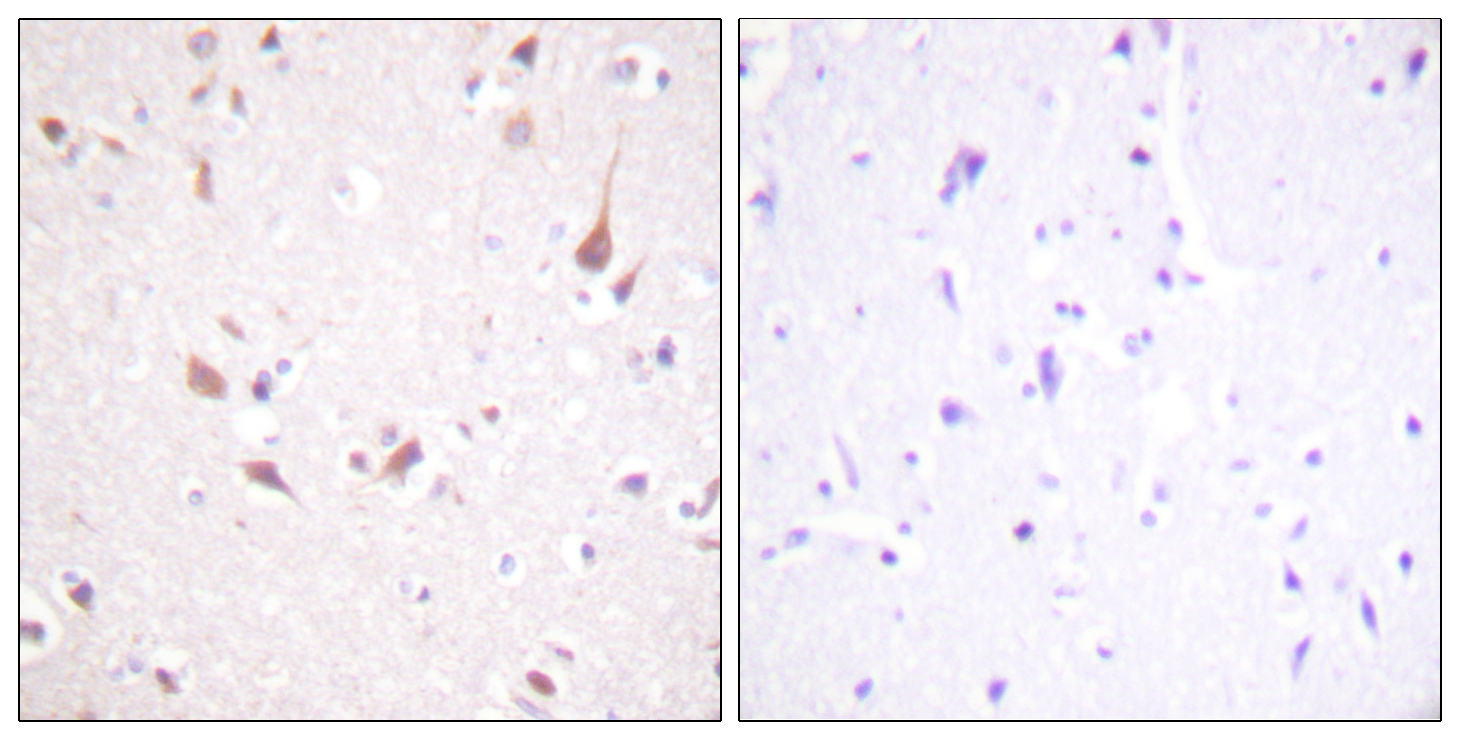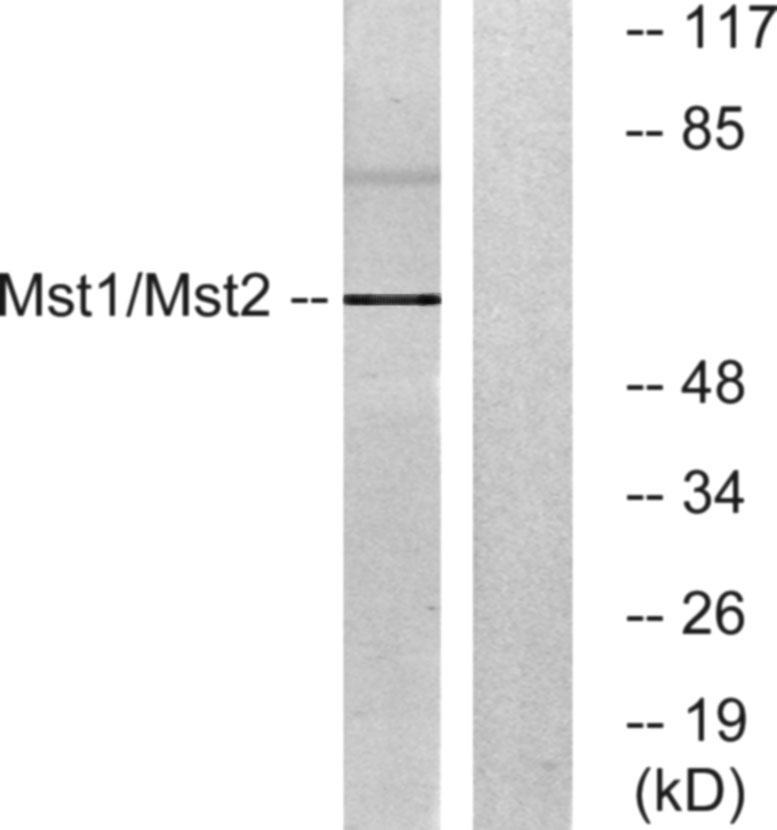Krs-1/2 Polyclonal Antibody
- Catalog No.:YT2495
- Applications:WB;IHC;IF;ELISA
- Reactivity:Human;Mouse
- Target:
- Krs-1/2
- Fields:
- >>MAPK signaling pathway;>>Hippo signaling pathway;>>Hippo signaling pathway - multiple species
- Gene Name:
- STK3/STK4
- Protein Name:
- Serine/threonine-protein kinase 3/4
- Human Gene Id:
- 6788/6789
- Human Swiss Prot No:
- Q13188/Q13043
- Mouse Gene Id:
- 56274/58231
- Immunogen:
- The antiserum was produced against synthesized peptide derived from human Mst1/2. AA range:149-198
- Specificity:
- Krs-1/2 Polyclonal Antibody detects endogenous levels of Krs-1/2 protein.
- Formulation:
- Liquid in PBS containing 50% glycerol, 0.5% BSA and 0.02% sodium azide.
- Source:
- Polyclonal, Rabbit,IgG
- Dilution:
- WB 1:500 - 1:2000. IHC 1:100 - 1:300. ELISA: 1:5000.. IF 1:50-200
- Purification:
- The antibody was affinity-purified from rabbit antiserum by affinity-chromatography using epitope-specific immunogen.
- Concentration:
- 1 mg/ml
- Storage Stability:
- -15°C to -25°C/1 year(Do not lower than -25°C)
- Other Name:
- STK3;KRS1;MST2;Serine/threonine-protein kinase 3;Mammalian STE20-like protein kinase 2;MST-2;STE20-like kinase MST2;Serine/threonine-protein kinase Krs-1;STK4;KRS2;MST1;Serine/threonine-protein kinase 4;Mammalian STE20-like prot
- Observed Band(KD):
- 56kD
- Background:
- serine/threonine kinase 3(STK3) Homo sapiens This gene encodes a serine/threonine protein kinase activated by proapoptotic molecules indicating the encoded protein functions as a growth suppressor. Cleavage of the protein product by caspase removes the inhibitory C-terminal portion. The N-terminal portion is transported to the nucleus where it homodimerizes to form the active kinase which promotes the condensation of chromatin during apoptosis. Multiple transcript variants encoding different isoforms have been found for this gene. [provided by RefSeq, Jan 2012],
- Function:
- catalytic activity:ATP + a protein = ADP + a phosphoprotein.,cofactor:Magnesium.,enzyme regulation:Inhibited by the C-terminal non-catalytic region. Activated by caspase-cleavage. Full activation also requires homodimerization and autophosphorylation of Thr-180, which are inhibited by the proto-oncogene product RAF1.,function:Stress-activated, pro-apoptotic kinase which, following caspase-cleavage, enters the nucleus and induces chromatin condensation followed by internucleosomal DNA fragmentation. Phosphorylates NKX2-1 (By similarity). Phosphorylates and activates LATS1 and LATS2.,similarity:Belongs to the protein kinase superfamily. STE Ser/Thr protein kinase family. STE20 subfamily.,similarity:Contains 1 protein kinase domain.,similarity:Contains 1 SARAH domain.,subcellular location:The caspase-cleaved form cycles between nucleus and cytoplasm.,subunit:Homodimer; mediated via the coil
- Subcellular Location:
- Cytoplasm . Nucleus . The caspase-cleaved form cycles between nucleus and cytoplasm (PubMed:19525978, PubMed:11278283). Phosphorylation at Thr-117 leads to inhibition of nuclear translocation (PubMed:19525978). .
- Expression:
- Expressed at high levels in adult kidney, skeletal and placenta tissues and at very low levels in adult heart, lung and brain tissues.
- June 19-2018
- WESTERN IMMUNOBLOTTING PROTOCOL
- June 19-2018
- IMMUNOHISTOCHEMISTRY-PARAFFIN PROTOCOL
- June 19-2018
- IMMUNOFLUORESCENCE PROTOCOL
- September 08-2020
- FLOW-CYTOMEYRT-PROTOCOL
- May 20-2022
- Cell-Based ELISA│解您多样本WB检测之困扰
- July 13-2018
- CELL-BASED-ELISA-PROTOCOL-FOR-ACETYL-PROTEIN
- July 13-2018
- CELL-BASED-ELISA-PROTOCOL-FOR-PHOSPHO-PROTEIN
- July 13-2018
- Antibody-FAQs
- Products Images

- Immunohistochemistry analysis of paraffin-embedded human brain tissue, using Mst1/2 Antibody. The picture on the right is blocked with the synthesized peptide.

- Western blot analysis of lysates from HeLa cells, treated with UV 15', using Mst1/2 Antibody. The lane on the right is blocked with the synthesized peptide.



